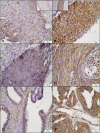Strong SOD2 expression and HPV-16/18 positivity are independent events in cervical cancer
- PMID: 29774090
- PMCID: PMC5955150
- DOI: 10.18632/oncotarget.24850
Strong SOD2 expression and HPV-16/18 positivity are independent events in cervical cancer
Abstract
It is well known that persistent infection with high-risk HPV (hr-HPV), mostly HPV-16 and 18, is the main cause of cervical cancer development. Manganese superoxide dismutase (MnSOD or SOD2) are highly expressed in different neoplasia. The present study investigated SOD2 protein expression and the presence of hr-HPV types in 297 cervical samples including non-neoplastic tissue, cervical intraepithelial neoplasia grade 3 (CIN3), squamous cell carcinoma (SCC) and adenocarcinoma (ADC). Strong SOD2 expression was significantly higher in ADC (82%) than CIN3 (52%) or SCC (64%). There was no association between SOD2 expression and HPV 16 and/or 18 detection for every lesion analyzed. Binary Logist Regression revealed that strong SOD2 expression (OR: 27.50, 6.16-122.81) and HPV 16 and/or HPV 18 (OR: 12.67, 4.04-39.74) were independently more associated with CIN3 than non-neoplastic cervix. Strong SOD2 expression (OR: 3.30, 1.23-8.86) and HPV 16 and/or HPV 18 (OR: 3.51, 1.03-11.87) were independently more associated with ADC than SCC. Similar findings for SOD2 expression were observed by the Cochran Mantel-Haenszel test, controlling for HPV-16 and/or HPV 18. In conclusion, the expression of SOD2 was increased in CIN3 and SCC, and more increased in cervical ADC than in SCC. Strong SOD2 expression was statistically independent of the presence of HPV 16 and/or 18. These findings suggest that the mitochondrial antioxidant system and HPV infection could follow independent pathways in the carcinogenesis of cervical epithelium and in the differentiation to SCC or ADC of the cervix.
Keywords: Pathology; adenocarcinoma; cervical intraepithelial neoplasia; human papillomavirus; squamous cell carcinoma; superoxide dismutase-2.
Conflict of interest statement
CONFLICTS OF INTEREST L.L Villa is a consultant/advisory board member for Merck. No potential conflicts of interest were disclosed by the other authors.
Figures




References
-
- Plummer M, de Martel C, Vignat J, Ferlay J, Bray F, Francheschi S. Global burden of cancers attributable to infections in 2012: a synthetic analysis [serial online] Lancet Glob Health. 2016;4:e609–e616. - PubMed
-
- de Sanjosé S, Serrano B, Castellsagué X, Brotons M, Muñoz J, Bruni L, Bosch FX. Human papillomavirus (HPV) and related cancers in the Global Alliance for Vaccines and Immunization (GAVI) countries. A WHO/ICO HPV Information Centre Report. Vaccine. 2012;30:D1–83. - PubMed
-
- Forouzanfar MH, Foreman KJ, Delossantos AM, Lozano R, Lopez AD, Murray CJ, Naghavi M. Breast and cervical cancer in 187 countries between 1980 and 2010: a systematic analysis. Lancet. 2011;378:1461–1484. - PubMed
-
- Fujiwara H, Yokota H, Monk B, Treilleux I, Devouassoux-Shisheboran M, Davis A, Kim JW, Mahner S, Stany M, Pignata S, Ray-Coquard I, Fujiwara K. Gynecologic Cancer InterGroup (GCIG) consensus review for cervical adenocarcinoma. Int J Gynecol Cancer. 2014;24:S96–101. - PubMed
LinkOut - more resources
Full Text Sources
Other Literature Sources
Research Materials

